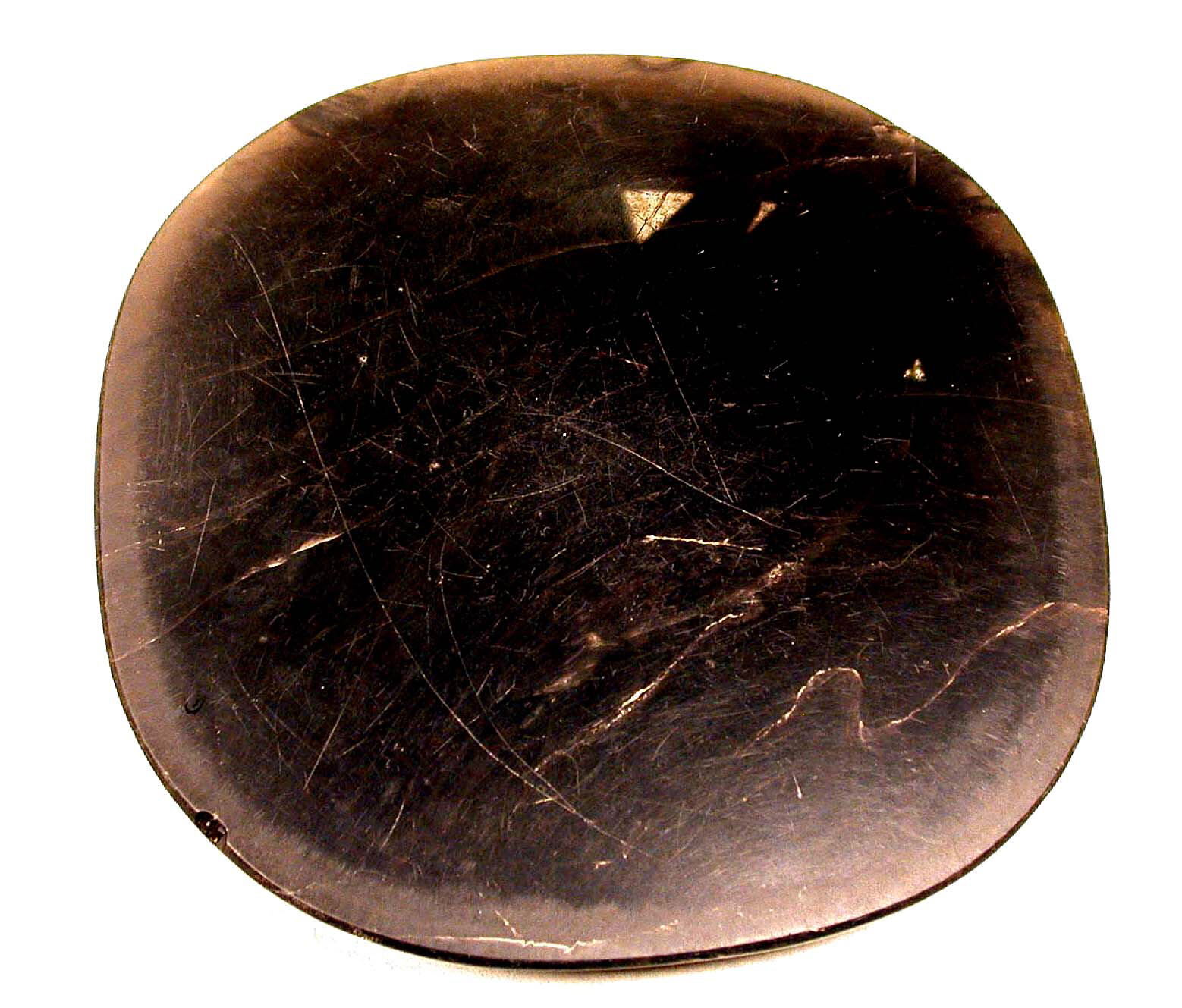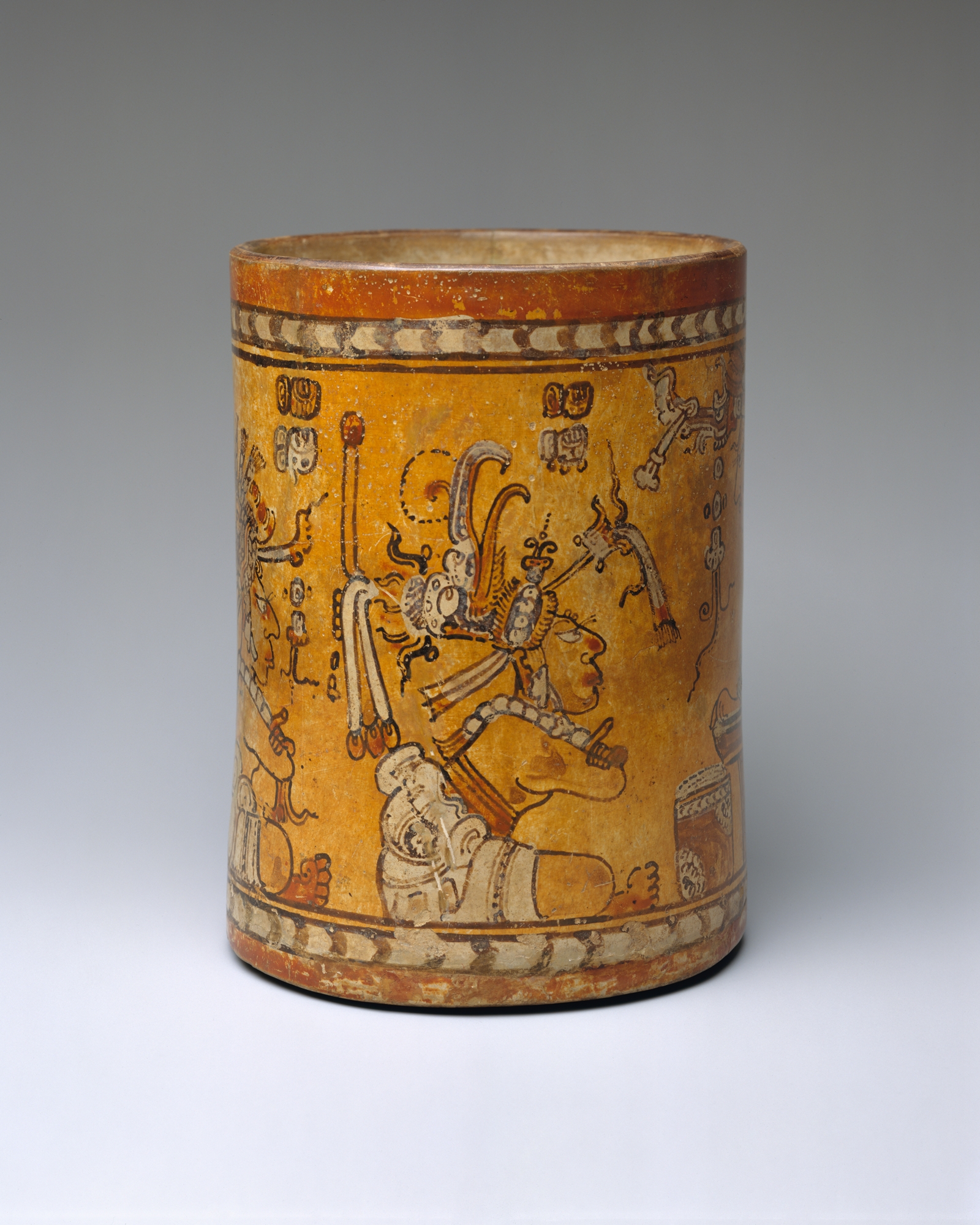Mayan's Magic Mirrors
Furthermore, the Mayan people saw the everyday world through their spirituality. Mayans considered light to be the means through which they could communicate with supernatural forces, therefore they manufactured a surface meant to reflect the light and to function as a portal for a relationship with deities. Thousands of years later, in Europe, the theological concept of light played an important role on its own architecture and art in gothic architecture.
They would manufacture glass windows that would reflect colorful light into its interior, inviting people into a deeper connection with God. Many generations have journeyed on the significance and influence of reflecting light in humanity. Therefore, this exhibition will explore the significance that reflecting light had on the Mayan’s everyday lives and how it was accurately depicted through their art.
Maya, Mirror-Bearer, 6th century, Cordia wood, MET 1979.206.1063
In this piece, a male body (probably a dwarf) kneeling in a fixed position is observed.
The male body is in an upright posture, slightly tilted back and clenching his arms while holding a prestigious pendant close to his chest. Although the “Mirror-Bearer” no longer holds a mirror, the straight lines formed by his arms, the compound breast ornaments and jewels, and the elaborated sagging skirt leads the eye to the space where a reflecting mirror would have been placed, framed by the arms and legs. The sculpture was likely holding a mirror crafted out of diverse materials such as obsidian, hematite, and pyrite.

Mexican, Mirror, before the 16th century, Obsidian, MET 1994.35.562
Probably the object that the “Mirror-Bearer” sculpture would have held between its arms
and sagging skirt. As Nicholas J. Saunders says, “Obsidian was centrally located in the physical
and symbolic worlds of indigenous societies, it was viewed by adornment by Catholic priests; but as
a syncretic continuation of pre-Columbian belief by native people,” (1). In other words, for the Mayan
people, the natural world was characterized by a spiritual essence and meaning. So when the light hit
these hand-crafted mirrors, a world of meaning would shine from them. Obsidian mirrors were likely
used by Mayans during spiritual rituals held in palaces, so “Mirror-Bearer” was likely used during
ceremonies and rituals as well. A detailed sculpture was carved in order to frame these precious
mirrors and to highlight its importance.
and sagging skirt. As Nicholas J. Saunders says, “Obsidian was centrally located in the physical
and symbolic worlds of indigenous societies, it was viewed by adornment by Catholic priests; but as
a syncretic continuation of pre-Columbian belief by native people,” (1). In other words, for the Mayan
people, the natural world was characterized by a spiritual essence and meaning. So when the light hit
these hand-crafted mirrors, a world of meaning would shine from them. Obsidian mirrors were likely
used by Mayans during spiritual rituals held in palaces, so “Mirror-Bearer” was likely used during
ceremonies and rituals as well. A detailed sculpture was carved in order to frame these precious
mirrors and to highlight its importance.

Maya, Censer, Seated King, 4th century, Ceramic, MET 1999.484.1a, b
Just like the “Mirror-Bearer,” this figure is seated too, cross-legged, holding a ritual object between
his arms and legs, which may be an obsidian mirror. This censer is another great example of the
importance laid on pyrite or obsidian hand-crafted mirrors and the role they played for spiritual
practices. The jade beads adornments and jewels help frame the importance of the ritual mirror.
Because the cross-legged figure may be a representation of an Early Classic Mayan ruler, perhaps
the technology of obsidian mirrors was only available to wealthier elites and only present in palaces.
This little carved image functions as a censer, and incense was present during Mayan ritual ceremonies.
Mayans thought incense was a way for them to communicate with their ancestors as well.
his arms and legs, which may be an obsidian mirror. This censer is another great example of the
importance laid on pyrite or obsidian hand-crafted mirrors and the role they played for spiritual
practices. The jade beads adornments and jewels help frame the importance of the ritual mirror.
Because the cross-legged figure may be a representation of an Early Classic Mayan ruler, perhaps
the technology of obsidian mirrors was only available to wealthier elites and only present in palaces.
This little carved image functions as a censer, and incense was present during Mayan ritual ceremonies.
Mayans thought incense was a way for them to communicate with their ancestors as well.

Maya, Vessel, Throne Scene, late 7th-8th century, Ceramic, MET 1999.484.2
On this drinking vessel, an example of a throne scene is depicted. The figure that is represented follows the same posture as “Mirror-Bearer” and it suggests its use and place. A kneeling figure before the throne, adorned by jewels of precious stones, gazing at the king in authority. The posture of the figure gradually bends forward as the vessel is moved to represent and, perhaps, suggests the reverence and respect required to be in front of authority. May also represent a ritual scene before the gods.
Maya, Polychrome vase with Enthroned Ruler, 550-900 AD, Earthenware and pigments, National Gallery of Australia, 82.2292.
The reunited individuals around the throne are all carrying an offering with their hands extended before the king. While the others are offering a gratifying smell before the king, a small kneeling figure stands right before him. The kneeling figure, likely to be a dwarf, suggests the use of the mirror as a reflector of light before the king. Light would come to reflect on the obsidian surface and bounce back the light on him; supposedly providing him a special connection to the deities and a portal to ancestors. Also, as the king saw his reflection on it, it was considered for him to be able to see deeper into the parts of him that could not be seen otherwise. Kneeling figures where indispensable before the throne, because they played a role in the kings highly valued spirituality.
Maya, Seated Male Figure with a Frame for a Mirror, Pre-Columbian, late Classic Period, wood with traces of gesso, Princeton University Art Museum y1990-71
Small sculpture of another dwarf holding a mirror. A dwarf was likely to be a lifelong companion of kings in Mayan culture, and all the dwarfs depicted in Mayan art are holding an obsidian or pyrite mirror. Artisans would cut thin pieces of obsidian or pyrite, finely polish them, and then attach them together forming a mosaic into the wood. This is an example of the remarkable importance that light-reflecting surfaces had for Mayan beliefs and spirituality. Mirrors were the primary tool for divination for the Mayan and were seen as portals. They had a very different usage and concept than modern day light-reflecting mirrors.
Works Cited
Saunders, Nicholas J. “A Dark Light: Reflections on Obsidian in Mesoamerica.” World
Archaeology, Vol. 33, No. 2, Archaeology and Aesthetics (Oct., 2001): 220-236.
No comments:
Post a Comment